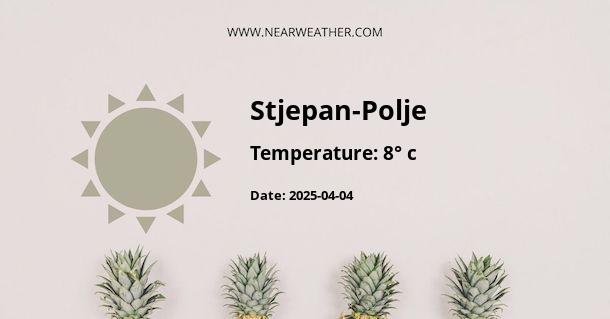Overview of Stjepan-Polje, Bosnia and Herzegovina
Stjepan-Polje is situated in Bosnia and Herzegovina, a country with a diverse climate influenced by its complex topography. As with much of the region, Stjepan-Polje experiences a continental climate with hot summers and cold winters. The proximity to the Dinaric Alps and the Balkan interior, as well as the Mediterranean influences, creates a unique climate profile for the area.
Climate Characteristics
The climate in Stjepan-Polje is characterized by its variety throughout the year. Typically, the environmental factors produce a mix of continental and Mediterranean traits. This is evident in the seasonal temperature fluctuations, the distribution of precipitation, and the impact of regional weather systems.
Temperature Patterns
- Summer: Summers are usually warm to hot, with daytime temperatures reaching into the upper 20s to mid-30s Celsius. Heatwaves can occur during this period, potentially driving temperatures higher.
- Autumn: The autumn season sees a gradual decline in temperatures, beginning warm and pleasant and transitioning to cooler conditions towards the end of the season. Despite this, autumn can be quite unpredictable with occasional warm spells.
- Winter: Winters are typically cold, with average temperatures often dropping below freezing. Snowfall is common, contributing to the area’s picturesque winter landscapes.
- Spring: Spring experiences a gradual warming trend, with late spring resembling early summer. This season often sees increased rainfall, fostering lush greenery throughout the surrounding landscapes.
Precipitation and Weather Events
Precipitation is spread throughout the year with some seasonality. Springs usually have higher rainfall, while late summer and autumn can experience drier periods. Extreme weather events, such as heavy snowfall in winter and severe thunderstorms in the summer, can occur.
Monthly Climate Breakdown
January
January is the coldest month with temperatures frequently plummeting below 0°C, and it often comes with significant snowfall.
February
February continues the winter chills but with slightly longer daylight hours. Late February may reveal the first signs of an approaching spring.
March
Temperatures start to rise in March, with the snow beginning to melt, but chilly weather can still dominate.
April
In April, spring is in full swing, and temperatures rise steadily, although nights can remain cold. Precipitation is common.
May
May brings further warmth and increasing daylight. Showers continue, with spring thunderstorms possible.
June
June is the onset of summer, with higher temperatures and longer days creating a pleasant climate for outdoor activities.
July
July is often the peak of summer, and temperatures can be quite high, especially during heatwaves.
August
August remains warm, though some regions might experience a slight drop in temperatures as summer progresses.
September
Autumn begins in September with comfortable temperatures, though climate variations can cause sudden weather changes.
October
October sees a more notable cooling trend as autumn advances, with an increased likelihood of rainfall.
November
In November, temperatures continue to decrease, and the area starts preparing for the winter cold.
December
Winter arrives in December, bringing shorter days and a high likelihood of snow, especially towards the New Year.
Annual Climate Statistics
For a more detailed and data-driven understanding of Stjepan-Polje's climate, we can consider the following compiled statistics:
Temperature Averages and Extremes
| Statistic | Value |
|---|---|
| Highest Recorded Temperature | Approximately 40°C |
| Lowest Recorded Temperature | Approximately -20°C |
| Annual Average High | Approximately 20°C |
| Annual Average Low | Approximately 5°C |
Precipitation Patterns
| Statistic | Value |
|---|---|
| Total Annual Precipitation | Approximately 1000mm |
| Wettest Month | May |
| Driest Month | August |
| Annual Snowfall | Varies, especially at higher elevations |
Winds and Cyclonic Systems
Wind patterns in Stjepan-Polje can be influenced by both local topographical features and broader regional weather systems. During certain times of the year, the area can be subjected to strong winds such as the Bora, which bring cold and dry conditions down from the northeast, and the Jugo, which is indicative of wet weather patterns moving in from the southeast.
Climate Influences and Environmental Concerns
Climate trends in Stjepan-Polje and the wider area are influenced by various regional and global factors, including the Mediterranean Sea's moderating effects, the sharp elevation changes of the Dinaric Alps, and broader atmospheric circulations. Recent climate change phenomena have brought increased scrutiny to long-term weather patterns, with experts observing shifts in temperature norms, precipitation timing, and frequency of extreme weather events.
Environmental concerns such as deforestation, air and water pollution, and urban development also play a role in local climate dynamics. Sustainable practices and policies are vital to preserving the natural climate balance and promoting resilience against climate change for Stjepan-Polje and neighboring regions.
Conclusion
Stjepan-Polje's climate is marked by a continental influence with Mediterranean touches, resulting in substantial seasonal variation and a diverse meteorological tapestry. Understanding the city's climate patterns is essential for residents and visitors alike, as weather impacts not just daily activities but also longer-term planning and environmental considerations.
A - Stjepan-Polje's Latitude is 44.717220 & Longitude is 18.259439.
A - Weather in Stjepan-Polje is 14° today.
A - Climate Conditions in Stjepan-Polje shows overcast clouds today.
A - Humidity in Stjepan-Polje is 90% today.
A - Wind speed in Stjepan-Polje is 6.91 km/h, flowing at 287° wind direction. today.
